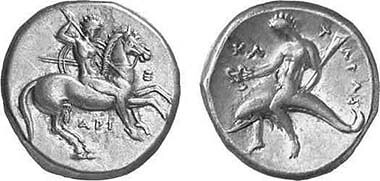
PREV ARTICLE
NEXT ARTICLE
FULL ISSUE
PREV FULL ISSUE
ARISTOTLE (AND MODERN COIN CATALOGERS) WRONGLY DESCRIBE TARENTUM STATER
Ursula Kampmann writes in CoinsWeekly this week about a long-ago mistake in interpreting a coin inscription, a mistake still carried on in the present day.
-Editor

Aristotle, in his work on the structure of the Tarentine government, likewise described the coins of the city. He remarked that they depicted Taras, son of Poseidon, riding a dolphin. As a matter of fact, on the South Italian coins we do find a young man who rides a dolphin and holds an object in his hand on most specimens. On this coin he holds a kantharos and a rudder, but there can be found spindles, jugs, wreaths, small dolphins and countless other things as well. To the figure's right the inscription TARAS is discernible, hence the nominative of the city of Tarentum which is quite unusual for a Greek coin. Ordinarily, the coins are designated with the genitive plural, therefore not Syracuse but (coin of the) Syracusans – to mention only one of countless examples. Aristotle concluded that the term Taras didn't denote the minting authority but the one represented, i.e. the name-giver of the city of Taras. Unfortunately, Classical tradition doesn't know of a Taras riding a dolphin. It connected that wandering legend, which often appears as part in other local myths as well, with Phalanthos whom the Tarentines revered as their founder. The founding legend of the city of Tarentum had it that long ago the sons of Spartan women and Helotes, a kind of slaves in service of the state in Sparta, rebelled against the governing Spartiates. Their leader was Phalanthos. The rebellion failed, the rebels were forced to exile and established, led by that very Phalanthos, a new city, Tarentum, conveniently situated near a natural harbor. It is safe to assume that the dolphin rider is Phalanthos for all contemporary legends refer to him as the one riding a dolphin. Aristotle simply misinterpreted the inscription on the coin. He didn't know that some Sicilian and South Italian cities didn't use the genitive plural on their coins – as was common in the mainland –, but the nominative singular. By the way, that was a mistake with consequences up to the present day. Many auction catalogs speak of Taras in their description of the dolphin rider. To read the complete article, see: And this is where Aristotle was wrong… (www.coinsweekly.com/en/Article-of-the-week/5) CAPTURE AND SHARE THE EXCITMENT!Wayne Homren, Editor The Numismatic Bibliomania Society is a non-profit organization promoting numismatic literature. See our web site at coinbooks.org. To submit items for publication in The E-Sylum, write to the Editor at this address: whomren@gmail.com To subscribe go to: https://my.binhost.com/lists/listinfo/esylum All Rights Reserved. NBS Home Page Contact the NBS webmaster 
|